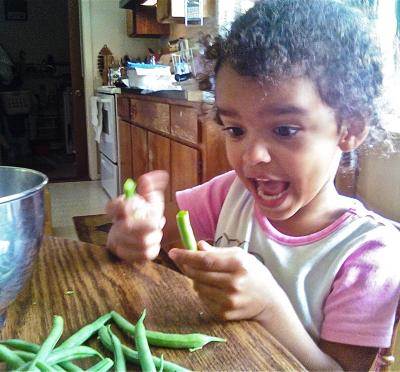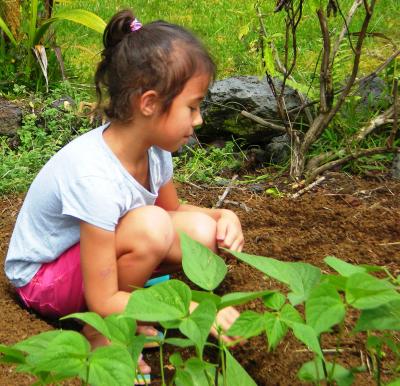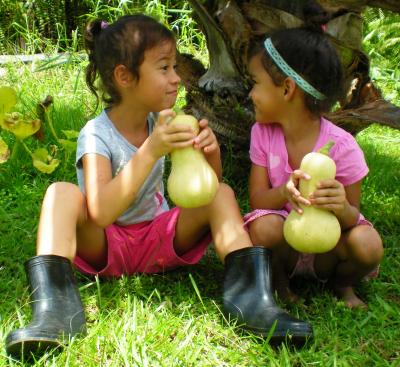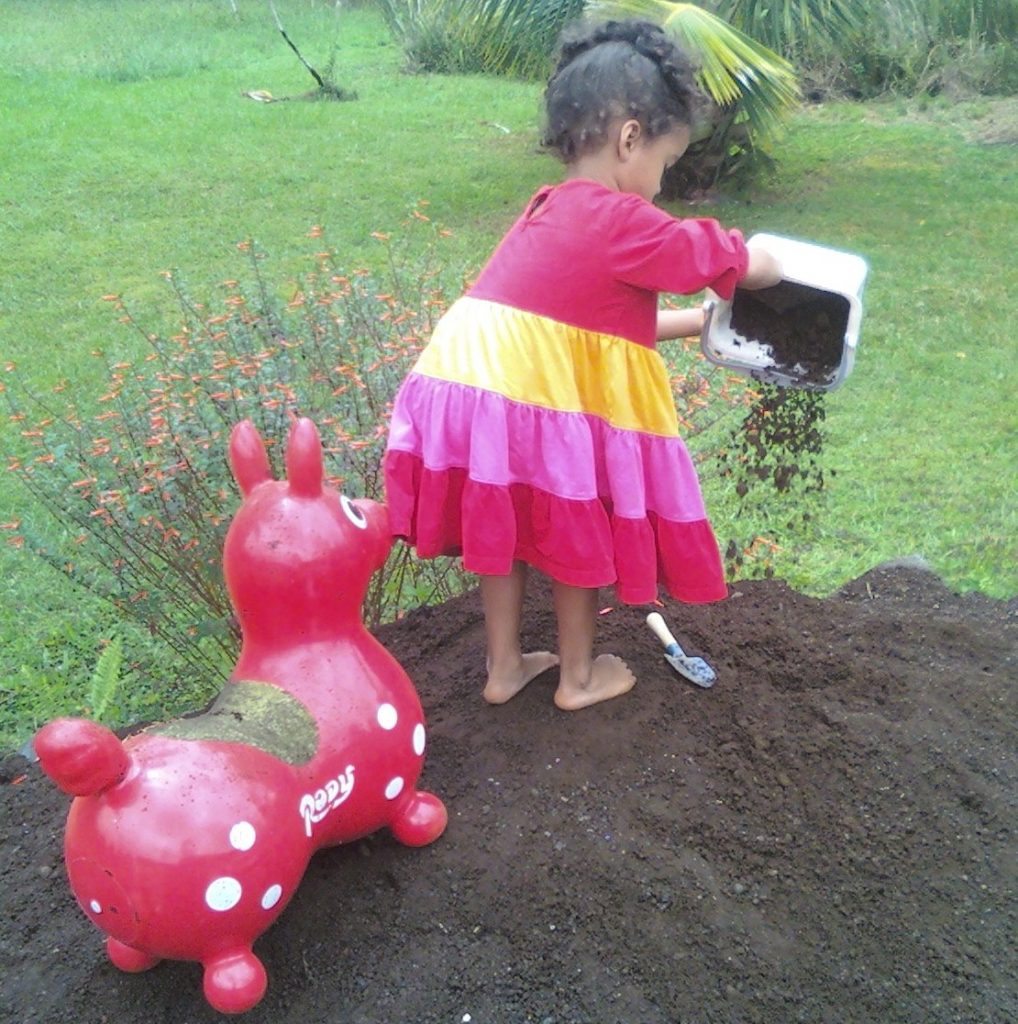
Living on islands surrounded by thousands of miles of ocean in every direction, Hawaii’s children are connected to the rhythms of tides and the seasons through the powerful, pervasive element of water. For those living on the Big Island, fire and air are also ever present elemental realities, as Pele spews out molten lava at will into the sea, affecting air quality. But the land – the land that can sustain us: direct experience working on and with it is not such an integral part of everyday life. Although we are on a rural and sparsely populated island, ninety percent or more of our foodstuffs are imported; much of this is adulterated, processed and far removed from the living sources of its origin.
For very young children, who live in the moment in a hands-on way, gardening serves to heal this disconnect through daily and seasonal attunement to the individuality of a backyard garden. In a LifeWays home childcare environment, they have the opportunity to work alongside and imitate adults doing practical, purposeful activities with the soil.
Nurtured by compost and natural soil enhancements, raked and made into rows, the brown bare earth becomes the home for seeds of many kinds, that then sleep quietly beneath rain and wind, sun and moon, until one day, the surface of the beds are studded with tiny bumps of green.
The wonder of it all! The plants grow, produce flowers that bees and butterflies visit, then one day, tiny, tiny beans or baby squash appear as it by magic. Together adults and children watch and wait. Finally, harvesting becomes part of the daily gardening rhythm, followed by washing, preparing, cooking and eating that which has grown out of the work of our hands and help from Mother Nature and the elemental beings.
 Gardening encompasses all four of the Living Arts: domestic, social, creative and nurturing. The four foundational senses: vestibular (balance), tactile (touch), proprioceptive (awareness of one’s body in space) and life (do I feel contentment within myself) – also find support within the multiple tasks involved in preparing and maintaining a garden. There is dirt to be shoveled, poked into, smoothed, shifted around, looked at, tasted; toes can wriggle into its warmth, and earthworms provide an ever fascinating source of entertainment and wonder. Plants must be tended: watered if it is too dry, protected if it is too rainy. Weeds need to be carefully removed. At just the right moments, fruit or vegetables must be harvested. Caregivers can nurture a child’s natural reverence, gratitude and appreciation as the food that was so recently growing in our garden, and on our trees, is shared together in a meal.
Gardening encompasses all four of the Living Arts: domestic, social, creative and nurturing. The four foundational senses: vestibular (balance), tactile (touch), proprioceptive (awareness of one’s body in space) and life (do I feel contentment within myself) – also find support within the multiple tasks involved in preparing and maintaining a garden. There is dirt to be shoveled, poked into, smoothed, shifted around, looked at, tasted; toes can wriggle into its warmth, and earthworms provide an ever fascinating source of entertainment and wonder. Plants must be tended: watered if it is too dry, protected if it is too rainy. Weeds need to be carefully removed. At just the right moments, fruit or vegetables must be harvested. Caregivers can nurture a child’s natural reverence, gratitude and appreciation as the food that was so recently growing in our garden, and on our trees, is shared together in a meal.
Process, Personal Learning, and Reflections
The first step for me in creating a small garden involved the selection of a spot close to the house, within reach of a hose or two, and in direct sunlight. Next came the rather arduous task of digging, pulling and wrangling twists of pokey roots and pilau maile vine out of the micro-thin layer of soil that covered a rough pile of broken up lava rock. This was not so easy and required the help of ‘Papa Craig’. (Here in Hawaii, older men are referred to respectfully and affectionately as ‘Papa’; older women as “Auntie’ or Tutu”.) Finally rock bottom was reached, and we created a low, jagged wall around out space.
We then had to determine the cost of a load of cinder soil – enough to provide a depth of 4-6 inches for a 10-12 foot oval garden – cost $200. Soil, what one thinks of with the word ‘dirt’ comes from the older parts of the island, up north; on this southern and eastern end of the island, the best we can hope for, unless one’s yard is fortunate enough to have a small pocket of earth, is ‘cinder soil’ – coarse crushed red or black volcanic cinder. We selected a load that also included rotted macadamia nut hulls.
The girls were very excited when the pick-up truck arrived, backed in through the side gate and deposited the mound of brown earth on one side of our ‘garden’. They eagerly helped over the next few days to spread it out and create the first beds. We couldn’t find a single earthworm in it, but at least, this wasn’t old cane soil, poisoned regularly over years by the sugar industry.
We celebrated our work to that point by going to the farmer’s market and purchasing golden marigolds and flame orange nasturtiums, as well as various organic seeds that I had heard ‘do well’ in our area. We planted and watered the flowers, taking time to enjoy their beauty and the satisfaction of a job well done.

Within the next two weeks, we planted yellow and green beans, kale, zucchini, winter squash and salad mix. And then, we waited.
Around this time, late spring to early summer, the lemons ripened, as did guava and avocados; the sweet fragrance of citrus blossoms from orange, tangerine and grapefruit perfumed the air: these would be ready to eat by Christmas. The homeowner Papa Craig periodically cuts us a few young coconuts, so we can enjoy the cool liquid inside then scoop out the jelly-like meat inside.
For me, the gardening experience was quite different than it had been in either of my two previous locations, or in my past extensive experiences living next to a biodynamic farm and having my own backyard garden. I learned after successive plantings (every two months) that beans work, squashes do not. Lettuce/ salad mix depends upon whether planting is followed by two weeks of steady rain or not. Collards and kale thrive. We decided that it is good we enjoy beans!
The day we pulled out old withered plants and found the soil full of wriggling worms of all sizes was a thrilling one! It’s texture six or so months from the arrival of that load of coarse cinder, is now crumbly, friable, and delightful to work with. The plants are healthier, too. We had been regularly adding composted goat manure, yard clippings and other organic soil supplements. Because of the intense sunlight and heavy rains, one must continually build up the soil: it does not otherwise hold its own against the elements.
During my four two-plus weeks away for each of the LifeWays sessions, I hoped for the best with my garden, but the weeds took advantage of my absence and the fertile soil, taking over and springing up to near shoulder height. During my final session this October/November, it rained so continuously and profusely, with at least two days where the total reached or exceeded 15 inches, that although the garden looked bedraggled when I returned at least even the weeds had suffered and were stunted.
Our compost pile was, and still is, simply a pile; it suffices but is not ideal. My plans are to find someone who can help me set up a proper pile using the BD starter. For now, yard clippings and our organic food scraps go into the mix, with some old goat manure and broken-down straw from Papa Jean’s goats mixed in. The girls help carry our blue enamel pail, at least once daily, out to ‘feed the earthworms’ that we know must live there under all of that rich pile.
I intend to talk with others in my area who have more organic gardening experience, so that I can broaden my understanding of optimal planting times, how to cope with the weather fluctuations and how to successfully produce more than beans and collards. I’d also like to plant dwarf apple banana keiki and maybe a tangelo.

The children have very much enjoyed all aspects of the garden, and working in and around it is now part of our daily/weekly routine whenever they are here. I have learned how truly unique each yard is, and how the slight variables from one person’s yard to another, even within a relatively few square miles, make the difference between success and failure in terms of producing food.
The LifeWays focus on the living arts, of which gardening is one small aspect, brings such balance and harmony into a childcare setting, and stands in sharp contrast to the typical, institutional programs and settings available to most families here in East Hawaii. I had ‘thought about’ starting a garden for many months since moving here to Pahoa, but the final ‘get going’ impetus originated in my training requirements list. How appreciative I am for the experience, which has helped me to get more in tune with the natural rhythms that surround me. I sit here viewing the marigold, nasturtiums and collards clearly through the rain, 20 feet outside of my bedroom door, thriving in spite of the two months of daily and nightly rain. It’s presence and the responsibility and pleasure of caretaking it, has become a meaningful part of life, inspired visiting friends to create their own, and in practical terms, provided us with healthy, fresh food for our daily meals. In a humble way, it has helped the children and I to be more intimately attuned to the subtle seasonal variations in nature. A backyard garden, even a very small one, brings the meaning of ‘eat local’ directly home in a satisfying way.

Pamela Perkins is the mother of three daughters and the grandmother of their four little girls. She lives 7 miles from an active volcano, amidst fragrant flowering plants and tree ferns on Hawaii Island, where she teaches both adults and young children, and works on her forthcoming publications. She wrote this paper as part of her LifeWays training, in 2010.
